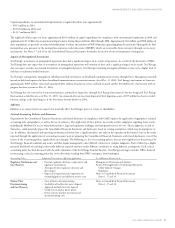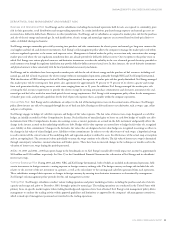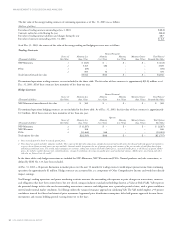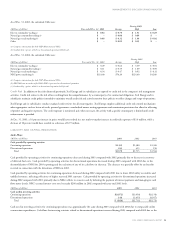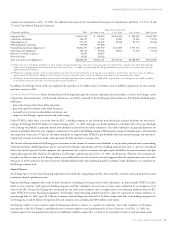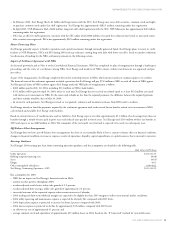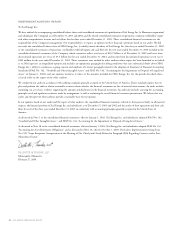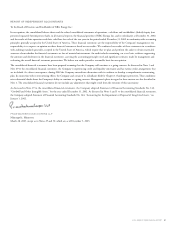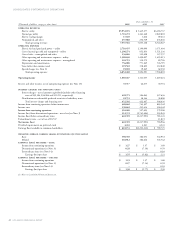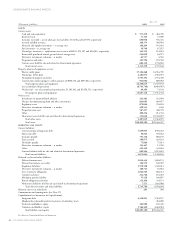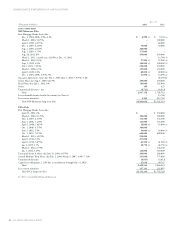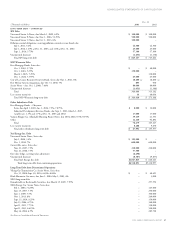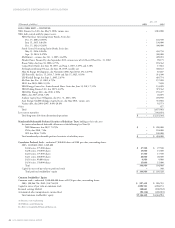Xcel Energy 2003 Annual Report Download - page 22
Download and view the complete annual report
Please find page 22 of the 2003 Xcel Energy annual report below. You can navigate through the pages in the report by either clicking on the pages listed below, or by using the keyword search tool below to find specific information within the annual report.
38 XCEL ENERGY 2003 ANNUAL REPORT
MANAGEMENT’S DISCUSSION AND ANALYSIS
by at least one nationally recognized rating agency. Finally, all outstanding securities (except preferred stock) that are rated must be rated investment
grade by at least one nationally recognized rating agency. On Feb. 20, 2004, Xcel Energy’s senior unsecured debt was considered investment grade by
Standard & Poor’s Ratings Services (Standard & Poor’s) and Moody’s Investors Services, Inc. (Moody’s).
Short-Term Funding Sources Historically, Xcel Energy has used a number of sources to fulfill short-term funding needs, including operating cash
flow, notes payable, commercial paper and bank lines of credit. The amount and timing of short-term funding needs depend in large part on financing
needs for construction expenditures. Another significant short-term funding need is the dividend payment.
In 2003, Xcel Energy established a money pool arrangement with the utility subsidiaries, subject to receipt of required state regulatory approvals. The
money pool allows for short-term loans between the utility subsidiaries and from the holding company to the utility subsidiaries at market-based interest
rates. The money pool arrangement does not allow loans from the utility subsidiaries to the holding company. State regulatory commission approval of
the arrangement is pending.
As of Feb. 20, 2004, Xcel Energy had the following credit facilities available to meet its liquidity needs:
Company (Millions of dollars) Facility Drawn*Available Cash Liquidity Maturity
NSP-Minnesota $ 275 $ 43 $232 $130 $ 362 May 2004
NSP-Wisconsin ––––––
PSCo 350 1 349 171 520 May 2004
SPS 125 40 85 21 106 February 2005 **
Xcel Energy – holding company*** 400 89 311 – 311 November 2005
Total $1,150 $173 $977 $322 $1,299
* Includes short-term borrowings and letters of credit.
** The SPS $100 million facility expired in February 2004 and was replaced with a $125 million unsecured, 364-day credit agreement.
*** Reflects the $400 million NRG payment made in February 2004.
Operating cash flow as a source of short-term funding is affected by such operating factors as weather; regulatory requirements, including rate recovery
of costs; environmental regulation compliance and industry deregulation; changes in the trends for energy prices; and supply and operational uncertainties,
which are difficult to predict. See further discussion of such factors under Statement of Operations Analysis.
Short-term borrowing as a source of funding is affected by regulatory actions and access to reasonably priced capital markets. For additional information
on Xcel Energy’s short-term borrowing arrangements, see Note 5 to the Consolidated Financial Statements. Access to reasonably priced capital markets
is dependent in part on credit agency reviews and ratings. The following ratings reflect the views of Moody’s and Standard & Poor’s. A security rating is
not a recommendation to buy, sell or hold securities and is subject to revision or withdrawal at any time by the rating company. As of Feb. 20, 2004,
the following represents the credit ratings assigned to various Xcel Energy companies:
Company Credit Type Moody’s Standard & Poor’s
Xcel Energy Senior Unsecured Debt Baa3 BBB-
Xcel Energy Commercial Paper NP A2
NSP-Minnesota Senior Unsecured Debt Baa1 BBB-
NSP-Minnesota Senior Secured Debt A3 BBB+
NSP-Minnesota Commercial Paper P2 A2
NSP-Wisconsin Senior Unsecured Debt Baa1 BBB
NSP-Wisconsin Senior Secured Debt A3 BBB+
PSCo Senior Unsecured Debt Baa2 BBB-
PSCo Senior Secured Debt Baa1 BBB+
PSCo Commercial Paper P2 A2
SPS Senior Unsecured Debt Baa1 BBB
SPS Commercial Paper P2 A2
Note: Moody’s highest credit rating for debt is Aaa1 and lowest investment grade rating is Baa3. Standard & Poor’s highest credit rating for debt is AAA+ and lowest investment
grade rating is BBB-. Moody’s prime ratings for commercial paper range from P1 to P3. NP denotes a nonprime rating. Standard & Poor’s ratings for commercial paper range
from A1 to A3, B and C. As of Feb. 10, 2004, Moody’s had Xcel Energy and its operating utility subsidiaries “under review for possible upgrade.” Standard & Poor’s had Xcel
Energy and its operating utility subsidiaries on “credit watch positive.”
In the event of a downgrade of its credit ratings below investment grade, Xcel Energy may be required to provide credit enhancements in the form of cash
collateral, letters of credit or other security to satisfy all or a part of its exposures under guarantees outstanding. See a list of guarantees at Note 15 to the
Consolidated Financial Statements. Xcel Energy has no explicit rating triggers in its debt agreements.
Registration Statements Xcel Energy’s Articles of Incorporation authorize the issuance of 1 billion shares of common stock. As of Dec. 31, 2003, Xcel Energy
had approximately 399 million shares of common stock outstanding. In addition, Xcel Energy’s Articles of Incorporation authorize the issuance of 7 million
shares of $100 par value preferred stock. On Dec. 31, 2003, Xcel Energy had approximately 1 million shares of preferred stock outstanding. Xcel Energy and its
subsidiaries have the following registration statements on file with the SEC, pursuant to which they may sell, from time to time, securities:





